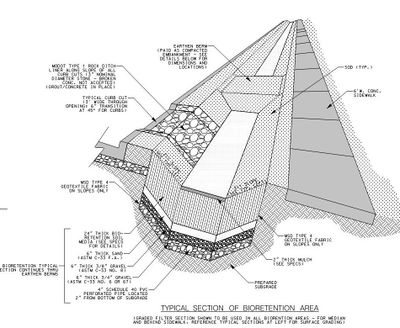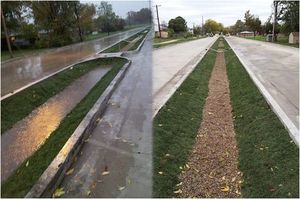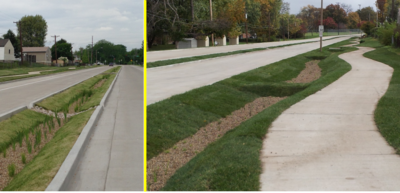
Case studies for dry swale (grass swale)
This page provides one detailed case study and several short summaries of case studies for dry swales.
Contents
International Plaza Drive Improvements
Project Summary – International Plaza Drive Improvements
Location: City of St. Ann, Missouri
Owners: City of St. Ann, Missouri
Designer: HR Green
Year of Completion: 2012
Design Features: Dry swale, rocked inlets and check dams
Total Drainage Area: 6-acres
Total Construction Cost: $770,500
HR Green worked with the City of St. Ann, Missouri to design a point of entry into the City. The pavement at this location was in disrepair. Evident ponding of stormwater occurred at the location and was one of the reasons for the pavement failure. This project is generally located south of Interstate 70, between Cypress Road and Ashby Road within the city limits of St. Ann, Missouri. International Plaza Drive is a designated collector roadway , running in the east-west direction, serving as a means to move traffic from local streets to nearby arterial roads.
Improvements for this project include the complete reconstruction of the roadway with new Portland cement concrete (PCC) pavement and integral curb, striped bike lanes, and a meandering concrete sidewalk/pathway. To address the requirements of the regulatory agencies with oversight, namely the Metropolitan St. Louis Sewer District (MSD), the City utilized engineered structures to address the water quality needs of the project. This approach minimized maintenance costs and maintenance activities associated with the use of a dry swale.
The project was designed in 2011 and constructed in 2012.
Design consideration summary
This project road design inverted the proposed roadway section and directed all of the roadway’s stormwater runoff into the center median. The existing curb inlets and appurtenances were no longer needed and were removed. The new drainage pattern results in stormwater runoff to four dry swales that receive flow from a total of 6.01 acres, with approximately forty to fifty percent of that total area being impervious surface. The project extent is 2.20-acres
Design general performance criteria for stormwater management for this project was based on Metropolitan St. Louis Sewer District (MSD) Section 4.080. Stormwater management was required because the redevelopment area exceeded 1 acre of disturbed area.
The dry swale drainage areas outside of the pavement section include an area inlet to serve as an overflow structure to accept flow from the typical 15-year, 20-min design storm. Earthen check dams or ditch checks were installed within the dry swale areas such that the maximum water elevation in these areas will be three (3) inches below the adjacent top of curb; any flow in excess of this volume will flow over the ditch checks and into the downstream area inlet. Depths of flow (15-year, 20-min) above the earthen check dams were calculated in order to verify that stormwater would not overtop the adjacent top of curb and onto the roadway. Berm placement is approximately every 200 to 400 feet along the dry swale and is constructed with a 1:1 slope and a two-foot width at the top. Soils at the site were Hydrologic Soil Group C and D.
The design intent was to follow all applicable rules and regulations, but circumstances within the design process required deviations from the guidelines, as noted below:
- Dry swale Area Side Slopes, 2:1
- Though 3:1 side slopes are preferred within dry swale areas, deviation from this preference was required in order to accommodate the total Water Quality Volume (WQV) for the entire project while staying within existing right-of-way limits, which is a requirement of the funding mechanism. Multiple options were investigated with respect to the total WQV, all which eventually resulted in adjusting the dry swale side slopes within the project area to 2:1. On a similar typical section for dry swales, the Maryland Stormwater Design Manual (2000) notes that 2:1 or flatter side slopes are to be used; the proposed side slopes do not exceed this slope requirement.
- To provide a means of protecting the side slopes from erosion due to concentrated stormwater runoff, a curb-cut detail with rock lining has been provided (see cross-section image on right) in the construction plans and this report for review. The intent of the rock lining is to slow the concentrated flow from the gutter to a velocity that will not erode the side slopes.
While these dry swales areas were sized to hold flows generated from a 1.14-in rainfall event, inevitably more intense storms will fall within the region. In these situations, the proposed area inlets installed at the downstream ends of the dry swale areas will capture excess stormwater and will be routed downstream to the existing system, consisting of intakes and pipes.
Some design complications were realized on this project as compliance with hydraulic grade line (HGL) requirements was difficult to attain in all areas of the storm sewer design. As a minimum, MSD notes that “…the [HGL] at any inlet or storm manhole shall not be higher than two (2) feet below the inlet sill or top of manhole.” However, due to the assumed HGL starting point within the Hydraflow model (pipe enters two reaches downstream of the connection point to the existing system), there are instances in the design where this requirement was unable to be attained. Through trial and error, the pipe sizes and flowlines of the proposed storm sewer system were tweaked in an attempt to correct this problem to no avail. Since the differential flow for the project is essentially non-existent, it is assumed that the existing system currently operates under this condition as well.
Applicable Costs
The cost to complete the roadway, bike and pedestrian sidewalks and associated items, signals, lighting, signing and striping, and landscaping and streetscaping was $770,428.
Summary of costs for dry swale case study - International Plaza Drive Improvements.
Link to this table
| Description | Unit | Quantity | Unit cost (dollars) | Extension (dollars) |
|---|---|---|---|---|
| Furnish/Place Type 1 ditch liner | Cubic yard | 3.2 | 80 | 257.78 |
| Ketucky Bluegrass sodding | Cubic yard | 1226.3 | 6 | 7.357.87 |
| Bermuda or Zoysia sodding | Square yard | 1963.6 | 7 | 13,744.87 |
| Mulch | Cubic yard | 25.7 | 30 | 771.40 |
| 3/8 inch gravel | Cubicyard | 268.5 | 40 | 10,738.73 |
| 3/4 inch gravel | Cubic yard | 268.5 | 40 | 10,783.73 |
| Sand | Cubic yard | 268.5 | 25 | 6,711.71 |
| Bioretention soil media | Cubic yard | 1073.9 | 50 | 53,693.67 |
| MSD Type 4 geotextile | Square yard | 1000.7 | 11 | 11007.88 |
| Plugs | Each | 1898 | 5 | 9490.00 |
| Shrubs (#5 container or 1-gallon container) | Each | 30 | 90 | 2.700 |
| Trees (2.5-inch caliper or 1-gallon container) | Each | 3 | 325 | 975.00 |
Maintenance
The ongoing maintenance of the dry swale was taken on by the City of St. Ann (link here for information on operation and maintenance of dry swales). Maintenance of the dry swale included the following.
- The dry swale area is intended to temporarily store stormwater and let it slowly soak into the ground. If standing water remains for longer than 3 days, the top of the planting bed has likely clogged. Clogging can be repaired by raking the surface, soil aeration (poking holes in the top layer of soil), or replacing the top 2-3 inches of planting soil and mulch.
- The plant species in the dry swale area were specifically selected and for this project included, but were not limited to, Fox Sedge, Soft Rush, Little Bluestem, Marsh Milkweed, Horsetail, Copper Iris, and New England Aster. These plants typically won’t require watering or fertilizing beyond their first year. Watering during drought periods will help plant appearance. As needed or desired, the City will replant the dry swale areas with compatible MSD approved plant species. Link here for information on plants for swales in Minnesota.
- The City will trim plants as needed to give them the “shape” they like. Between November and March, plants will be cut near the ground surface. The City will leave seed heads through winter for bird and wildlife watching.
- Weeds will be pulled and spot use of herbicides will be implemented, but blanket herbicide application is not recommended. The insects and birds living around a healthy dry swale area keep mosquito populations in check.
- Rainwater flowing into the basin may carry trash and debris. Inlet pipes and “pop-ups” will be checked and cleaned as needed. Trash, debris, leaf litter, and sediment will be removed regularly to ensure that the dry swale area is not clogged and does not fill-in. Trash, debris, and sediment collected in the dry swale area will be disposed with other household waste. Material suspected to be polluted by oil, old paint chips (lead), or other chemicals that could potentially be hazardous should be properly tested and disposed in accordance with state and federal hazardous waste regulations.
- When cleaning a BMP, standing “clear, unpolluted water” can be decanted and discharged to the storm system. Water that has become turbid during cleaning should be either, (1) pumped and hauled to an acceptable wastewater disposal facility or (2) treated by filtration, such as pumped through a bag filter, and discharged to the sanitary sewer system. A special discharge permit from MSD is not required for discharging to the sanitary system if the total volume is less than 10,000 gallons. The flow rate pumped into the sanitary system shall not exceed 50 gallons per minute (gpm).
An Annual BMP Maintenance Report is submitted to MSD by the City of St. Ann before March 31st. A MSD inspector periodically inspects the BMP.
Links to and summaries of other case studies
Below are summaries of additional case studies for dry swales..
Gene Green Beltway 8 Park - Houston, Texas
A project incorporating bioswales into a local park located east of downtown Houston, Texas. The document describing the project provides a summary of the project, including design, expected pollutant removal, LEED features. Includes detail drawings; soil mixes used; information on underdrains, curbs, and inlets; plant materials; landscaping; maintenance; cost information; photos and schematics. Source: Houston Land Water Sustainability Forum.
North Carolina
This PowerPoint presentation, Low Impact Development in the Transportation Environment: Lessons Learned in North Carolina (Winston, 2014), summarizes several case studies utilizing swales. The focus is on different design options and features and their effect on swale performance. Includes some design information, performance results, and numerous photos, schematics, and other images.
Springfield, Oregon
Three bioswales were constructed at the Lane Transit District (LTD) Springfield Station, Springfield, Oregon. Two swales function as major elements and one as a minor element. This case study provides a minimum of information on design but provides a summary of monitoring conducted at the site. Link.
Oregon Department of Environmental Quality
Biofilters For Stormwater Discharge Pollution Removal - Excerpt from this document: "This document is an attempt to compile the best available information on the design and use of biofilters (bioswales, vegetated filter strips, and constructed wetlands) so that those sites that may have an application of one or the other of these vegetated filtering systems will have information to make the best decision on the design, construction, implementation, and maintenance of these Best Management Practices. It is not a design manual but a practical, based on experience and knowledge of sites that implemented these BMPs, useful information on what works and does not work when designing, constructing, and operating them."
Cornell University
"A bioswale was installed as part of the Nevin Welcome Center building project in 2010. The project, which includes a green roof, and several other sustainable features, received LEED Gold from the U.S. Building Council. The bioswale was designed to slow and clean storm water runoff from the parking lot while providing an attractive garden landscape, which is more ecologically-minded than a traditional storm drain system. The garden is used as a teaching landscape to showcase the benefits and functions of a bioswale garden."
The study report for this project focuses on sustainable features of this project.
Related pages
- Terminology for swales (grass channels)
- Overview for dry swale (grass swale)
- Types of infiltration
- Types of filtration
- Design criteria for dry swale (grass swale)
- Construction specifications for dry swale (grass swale)
- Operation and maintenance of dry swale (grass swale)
- Assessing the performance of dry swale (grass swale)
- Calculating credits for dry swale (grass swale)
- Cost considerations for dry swale (grass swale)
- Case studies for dry swale (grass swale)
- Plants for swales
- Check dams for stormwater swales
- External resources for dry swale (grass swale)
- References for dry swale (grass swale)
- Requirements, recommendations and information for using dry swale (grass swale) without an underdrain in the MIDS calculator
- Requirements, recommendations and information for using dry swale (grass swale) with an underdrain in the MIDS calculator
- Requirements, recommendations and information for using swale side slope as a BMP in the MIDS calculator





